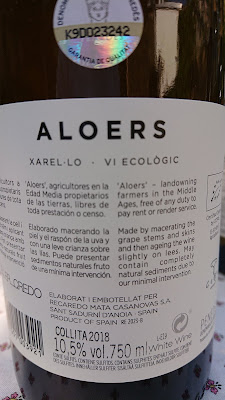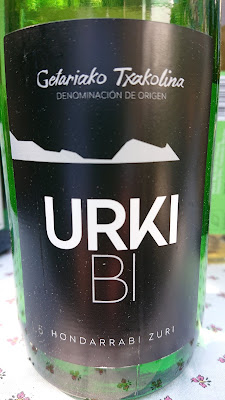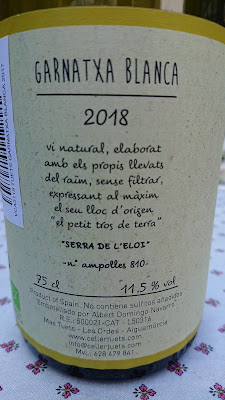 |
| Westwell's Ortega Orange Wine from Sussex. 11.5% |
To be clear, we're not looking for watery or neutral wines although some of these can be refreshing. We actually prefer something aromatic - something to tickle the taste buds and we have been heartened to see that those characteristics don't depend on alcohol content.
 |
| Penedes |
Thanks mainly to Spanish whites from Penedes available from the great Catalonian on and off-line merchant Grau (Liqores Grau, Palafrugell/www.grauonline.es) but also to others, not least English winemakers, here are more lower alcohol whites than you could shake a stick at - and that's not including Riesling!
We are arranging our list in ascending order of alcoholic content as a protest against all those who think it more important to mention the service temperature, the food and wine matchng', the soil types etc. Do they do that intentionally or do they forget to state this crucial piece of information?
We should admit walking by shelves of Penedes wines in wine shops without a flicker of interest. This was entirely due to ignorance and lack of curiosity.
Writing in the 1990s, the great Spanish wine expert John Radford was able to relegate the type of wines we are talking about here as 'everyday whites...[from] "the big three" Catalan varieties (Macabeo, Xarel-lo and Parellada) while referring to Chardonnay, Pinot Noir, Cabernet Franc, Gewurtztrameiner and Riesling as 'the most delicate grapes.' He does however speculate that 'more than 120 varieties are native to Catalonia: any of them could suddenly find a new lease of life...'
Could that be what has happened now, 22 or 23 years on? We found many of the following wines absolutely outstanding. In particular Xarel-lo stands out with Parellada perhaps not really showing huge potential but the winemakers of Penedes can really make successful blends and we predict many such wines as these will fetch higher prices in future. At the moment they are terrific bargains.
9.5%
Celler Credo's Volaina is 100% Parellada. Perhaps not the pick of the bunch but unobjectionable and particularly low in alcohol.
Kerner is an interesting crossing between Trollinger and Riesling (August Herold, 1929). It can be rather alcoholic, especially when grown in the Alto Adige but we like the Kerner from Worcestershire made by Astley Vineyard and called 'Veritas.' We were once told by the winemaker that Kerner is very high maintainance.
This Spatlese version at 9.5% is probably sweet. Mal sehen.
10.5%
Sumarroca's Blanc de Blancs is a blend of Muscat, Macabeo, Parellada and Xarelo.
Xarel-Lo in purezza. This had a hint of the 'natural' about it with plenty of taste. The aging on lees was palpable. Outstanding. 13,00€.
Made from Moscatel (50%), Macabeo (30%) and Parellada (20%). Attractive perfume bottle! In other years the Abv. may vary.
11%
An English Chardonnay from Henners, a mainly sparkling wine producer from East Sussex, not far from Herstmonceaux. The estate now belongs to Boutinot. This wine is beautiful and delicate and makes you think there is just as much validity in this lighter style as the most luscious Bourgogne or New World.
Chardonnay, Xarel-Lo, Macabeo and Moscatell.
As it says on the label, Macabeu and Parellada. O si sic omnes.
Familia Gramona's Gessami has some interesting English on the back label;
Run along the beach, peeled knees, friends, lovers, family. The smell of the garden of grandparent's house. Gessami, a wine of memories and joys. A wine to love the wine.
The grapes are Sauvignon Blanc, Muscat, Gewürztraminer.
Gessami is Catalan for Jasmin.
'Look' is made from Xarel-Lo, Moscatel de Frontignan, Sauvignon Blanc, Chardonnay and Macabeu.
Xarel-Lo
Txakoli or Chakoli is the name of a type of wine from the Basque country in Spain. It can be made from different grape varieties, This wine is a blend of Hondarribi Beltza - a red grape (Beltza means black in Basque) and Hondarribi Zuri (Zuri means 'white'). The name of the winery is Txakoli Akarregi Txiki. Getariako Txakolina is the D.O. Getaria is the main town.
There are Txakolis also from Biscay, Cantabria, Alava and Burgos. Apart from the two Hondarribis,
other grapes are also permitted include Bordeleza Zuria (Folle Blanche), Izkiriota Ttipia (Petit Manseng), Izkiriota (Gros Manseng) and Courbu. Sauvignon Blanc, Chardonnay and Riesling are also authorised.
Historically another light red variety called Oilar Begi ("chicken eye") was also used. This variety had almost become extinct but is making a slow comeback.

And here is a picture of a bottle of Txakoli Oilar Begi DO Bizkaiko.We just have to find this wine whatever the Abv!
95% of Txakolis are white but there are also rose and red Txakolis and even a (white) late harvest Txakoli.
Txomin Etxaniz's is a blend of Hondarribi Beltza and Hondarribi Zuri.
Hondarribi Zuri in purezza.
And now for something completely different. A Gevrey Chambertin Aligote at 11%. Rather oaky but OK all the same.
11.5%
An English Chasselas? Why not?
An Orange wine in fact but what is an Orange wine? Only a white wine with long skin contact. We couldn't resist this one from Ortega, one of our favourite grapes grown in the UK.
We don't know of any other Orange wine made from this aromatic variety.
Parellada and Muscat de Frontignan.
Xarel-Lo and Macabeu
Ever since a delicious Grenache Blanc by Amphorae at the Santa Katarina restaurant in Tel Aviv last year we have been wondering where this wonderful grape has been all our lives. Probably to often hidden in blends We were glad to find these two at 11.5%. ('Tuets' meaning you are in Catalan was priced at 11,01€)
Grenache Blanc is often quite high in alcohol. At 11.5%, this one lacked nothing that the 13.5% examples had to offer except a thick head the morning after perhaps? Delicious. A bit more expensive than the others at 16,52€.
Xarel-Lo. How about that label? The winery is Marti Serda. 9,66€
Parellada, Macabeo, Xarel.lo. Macabeu is also known as Viura by the way.
Macabeu, Parellada, Xarel·lo.
Straight Macabeu. Macabeu is actually the Catalan for Macabeo.
Xarel·lo and Moscatell. If you look up Moscatel or Moscatell in 'Wine Grapes' it says 'see Muscat.' Muscat is known as Moscatel in Spain and Portugal.
Xarel-Lo and Macabeu
Moscatell and Xarel-Lo
Parellada. Why Honeymoon? Maybe because it's on the sweet side?
Xarel-Lo as it says.
Incrocio Manzoni, would you believe?
Looking at the main grape varieties employed in these Penedes whites, it's remarkable how almost each wine manages a unique permutation. Leaving aside Garnatxa Blanca and Incrocio Manzoni, there are 7 varieties in play. Out of 25 wines only 5 manage to have the same blend as another.
The native varieties are Macabeu, Parellada and Xarel-Lo with international varieties Chardonnay, Gewurtztraminer, Moscatel (or Muscat de Frontignon) and Sauvignon Blanc.
The most common of these wines is a straight Xarel-Lo; 4 in number. The only others which duplicate the blend with one each are Macabeo/Xarel-Lo, Macabeo/Xarel-Lo/Parellada and Moscatel/Xarel-Lo.
Independent these Penedes producers!
From Sachsen, not Catalunya. This is an old favourite. N/A UK it is worth importing from a merchant in Germany such as perbaccowein.de of Hanover who are very pleasant to deal with as well as efficient. Their shipping charges are very low indeed and the wine arrives without delay.
We love Elbling. It's not just an alternative to Riesling thank you very much.
Scheurebe from Franken. Interessant!
Vernaza Zinesa. This is a curious one. The name may be dialect for Vernaccia Cinese. In any case Vernaza Zinesa is, according to XtrWine - the merchant from whom we bought it - a synonym for Biancaccia bianca., Vernaccia a foglia glabra, Vernazza minore e gentile, Pavana bianca., Bianca cinese, Cenese, Vernaccia o Vernanzina del Vicentino.
D'Agata has an answer to what all this might mean but you have to go to his entry on Bianchetta Treviggiana to get the story because of the above only Pavana has a separate entry in his 'Native Wine Grapes of Italy.'
Bianchetta is one of many Italian natives named on the basis of skin color, which means there are many unrelated "Bianchetta" varieties all over Italy that have only a pale hue in common. To furthe complicate matters, Bianchetta Trevigiana has always been known under a variety of other names, including Bianca Gentile di Fonzaso, Biancara, Bianchetta, Bianchetta Gentile, Pavana Bianca and Pignola Bianca. Other names were used only in specific areas: Senese in Breganze, Vernanzina in the Colli Berici, Vernassina in the Colli Eugeanei and vernaccia, Vernazza or Vernaccia Trentina in the Trentino and Alto Adige regions. This is because local farmers were always convinced their grape was different than that of others. We know today that many of these synonyms are wrong, as they refer to varieties such as Pavana which are distinct from Bianchetta Trevigiana.
We think we are in the same ball park as Vernaza Zinesa here.
11.8%
What was this? A 100% Muscadelle from Genissac, just south of Libourne - technically in the Entre Deux Mers region. We had come across Muscadelle in Boreaux whites of course. It tended to get a mention after Sauvignon and Semillon and it seems we had never taken a closer look at it, assuming it was a local name for one of the meny Muscats. Wrong. Muscadelle isn't related to Muscat at all. It's a stand-alone variety found only in Bordeaux. This was the first example of a Muscadelle in purezza we had ever seen and we were glad we saw it, bought it and most importantly tasted it. It is on the off-dry side but floral rather than sweet. It doesn't taste like a Muscat. It is really rather good and deserves to be a great deal better known. We loved the ironic name. Or maybe 'Nobody's Perfect' wasn't ironic, encapsulating people's attitude to the grape rather than the grape itself.












































































No comments:
Post a Comment